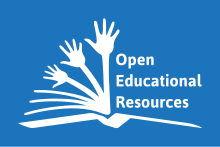Open content
Open content describes any work that others can copy or modify freely by attributing to the original creator, but without needing to ask for permission. This has been applied to a range of formats, including textbooks, academic journals, films and music. The term was an expansion of the related concept of open-source software.[1] Such content is said to be under an open licence.

History
The concept of applying free software licenses to content was introduced by Michael Stutz, who in 1994 wrote the paper "Applying Copyleft to Non-Software Information" for the GNU Project. The term "open content" was coined by David A. Wiley in 1998 and evangelized via the Open Content Project, describing works licensed under the Open Content License (a non-free share-alike license, see 'Free content' below) and other works licensed under similar terms.[1]
It has since come to describe a broader class of content without conventional copyright restrictions. The openness of content can be assessed under the '5Rs Framework' based on the extent to which it can be reused, revised, remixed and redistributed by members of the public without violating copyright law.[2] Unlike free content and content under open-source licenses, there is no clear threshold that a work must reach to qualify as 'open content'.
Although open content has been described as a counterbalance to copyright,[3] open content licenses rely on a copyright holder's power to license their work, similarly as copyleft which also utilizes copyright for such a purpose.
In 2003 Wiley announced that the Open Content Project has been succeeded by Creative Commons and their licenses, where he joined as "Director of Educational Licenses".[4][5]
In 2005, the Open Icecat project was launched, in which product information for e-commerce applications was created and published under the Open Content License. It was embraced by the tech sector, which was already quite open source minded.
In 2006 the Creative Commons' successor project was the Definition of Free Cultural Works[6] for free content, put forth by Erik Möller,[7] Richard Stallman, Lawrence Lessig, Benjamin Mako Hill,[7] Angela Beesley,[7] and others. The Definition of Free Cultural Works is used by the Wikimedia Foundation.[8] In 2008, the Attribution and Attribution-ShareAlike Creative Commons licenses were marked as "Approved for Free Cultural Works" among other licenses.[9]

Another successor project is the Open Knowledge Foundation (OKF),[10] founded by Rufus Pollock in Cambridge, UK in 2004[11] as a global non-profit network to promote and share open content and data.[12] In 2007 the Open Knowledge Foundation gave an Open Knowledge Definition for "Content such as music, films, books; Data be it scientific, historical, geographic or otherwise; Government and other administrative information".[13] In October 2014 with version 2.0 Open Works and Open Licenses were defined and "open" is described as synonymous to the definitions of open/free in the Open Source Definition, the Free Software Definition and the Definition of Free Cultural Works.[14] A distinct difference is the focus given to the public domain and that it focuses also on the accessibility ("open access") and the readability ("open formats"). Among several conformant licenses, six are recommended, three own (Open Data Commons Public Domain Dedication and Licence (PDDL), Open Data Commons Attribution License (ODC-BY), Open Data Commons Open Database License (ODbL)) and the CC BY, CC BY-SA, and CC0 creative commons licenses.[15][16][17]
"Open content" definition
The OpenContent website once defined OpenContent as 'freely available for modification, use and redistribution under a license similar to those used by the open-source / free software community'.[1] However, such a definition would exclude the Open Content License (OPL) because that license forbade charging 'a fee for the [OpenContent] itself', a right required by free and open-source software licenses.
The term since shifted in meaning. OpenContent "is licensed in a manner that provides users with free and perpetual permission to engage in the 5R activities."[2]
The 5Rs are put forward on the OpenContent website as a framework for assessing the extent to which content is open:
- Retain – the right to make, own, and control copies of the content (e.g., download, duplicate, store, and manage)
- Reuse – the right to use the content in a wide range of ways (e.g., in a class, in a study group, on a website, in a video)
- Revise – the right to adapt, adjust, modify, or alter the content itself (e.g., translate the content into another language)
- Remix – the right to combine the original or revised content with other open content to create something new (e.g., incorporate the content into a mashup)
- Redistribute – the right to share copies of the original content, your revisions, or your remixes with others (e.g., give a copy of the content to a friend)[2]
This broader definition distinguishes open content from open-source software, since the latter must be available for commercial use by the public. However, it is similar to several definitions for open educational resources, which include resources under noncommercial and verbatim licenses.[18][19]
The later Open Definition by the Open Knowledge Foundation (now known as Open Knowledge International) define open knowledge with open content and open data as sub-elements and draws heavily on the Open Source Definition; it preserves the limited sense of open content as free content,[20] unifying both.
Open access

"Open access" refers to toll-free or gratis access to content, mainly published originally peer-reviewed scholarly journals. Some open access works are also licensed for reuse and redistribution ("libre open access"), which would qualify them as open content.
Open content and education

Over the past decade, open content has been used to develop alternative routes towards higher education. Traditional universities are expensive, and their tuition rates are increasing.[21] Open content allows a free way of obtaining higher education that is "focused on collective knowledge and the sharing and reuse of learning and scholarly content."[22] There are multiple projects and organizations that promote learning through open content, including OpenCourseWare Initiative, The Saylor Foundation and Khan Academy. Some universities, like MIT, Yale, and Tufts are making their courses freely available on the internet.[23]
Textbooks
The textbook industry is one of the educational industries in which open content can make the biggest impact.name =Khing Phyo San "funny monkey">Fitzgerald, Bill (2012). "Using Open Content To Drive Educational Change". Funny Monkey. Retrieved 18 April 2012.</ref> Traditional textbooks, aside from being expensive, can also be inconvenient and out of date, because of publishers' tendency to constantly print new editions.[24] Open textbooks help to eliminate this problem, because they are online and thus easily updatable. Being openly licensed and online can be helpful to teachers, because it allows the textbook to be modified according to the teacher's unique curriculum.[25] There are multiple organizations promoting the creation of openly licensed textbooks. Some of these organizations and projects include The University of Minnesota's Open Textbook Library, Connexions, OpenStax College, The Saylor Foundation Open Textbook Challenge and Wikibooks
Licenses
According to the current definition of open content on the OpenContent website, any general, royalty-free copyright license would qualify as an open license because it 'provides users with the right to make more kinds of uses than those normally permitted under the law. These permissions are granted to users free of charge.'[2]
However, the narrower definition used in the Open Definition effectively limits open content to libre content, any free content license, defined by the Definition of Free Cultural Works, would qualify as an open content license. According to this narrower criteria, the following still-maintained licenses qualify:
- Creative Commons licenses (only Creative Commons Attribution, Attribution-Share Alike and Zero)
- Open Publication License (the original license of the Open Content Project, the Open Content License, did not permit for-profit copying of the licensed work and therefore does not qualify)
- Against DRM license
- GNU Free Documentation License (without invariant sections)
- Open Game License (a license designed for role-playing games by Wizards of the Coast)
- Free Art License
(For more licenses see Open Knowledge, Free content and Free Cultural Works licenses)
See also
References
- Wiley, David (1998). "Open Content". OpenContent.org. Archived from the original on 28 January 1999. Retrieved 17 April 2012.
- Wiley, David. "Open Content". OpenContent.org. Retrieved 18 November 2011.
- "Lawrence Liang, "Free/Open Source Software Open Content", Asia-Pacific Development Information Programme: e-Primers on Free/Open Source Software, United Nations Development Programme – Asia-Pacific Development Information Programme, 2007" (PDF). Retrieved 23 June 2012.
- OpenContent is officially closed. And that's just fine. on opencontent.org (30 June 2003, archived)
- Creative Commons Welcomes David Wiley as Educational Use License Project Lead by matt (23 June 2003)
- "Revision history of "Definition" – Definition of Free Cultural Works". Freedomdefined.org. Retrieved 14 November 2012.
- "History – Definition of Free Cultural Works". Freedomdefined.org. Retrieved 14 November 2012.
- "Resolution:Licensing policy". Wikimedia Foundation. Retrieved 14 November 2012.
- "Approved for Free Cultural Works". Creative Commons. 24 July 2009. Retrieved 14 November 2012.
- Davies, Tim (12 April 2014). "Data, information, knowledge and power – exploring Open Knowledge's new core purpose". Tim's Blog. Retrieved 25 October 2015.
- "Open Knowledge Foundation launched". Open Knowledge Foundation Weblog. Retrieved 25 October 2015.
- "Open Knowledge: About". okfn.org. Retrieved 25 October 2015.
- version 1.0 on opendefinition.org (archived 2007)
- Open Definition 2.1 on opendefinition.org
- licenses on opendefintion.com
- Creative Commons 4.0 BY and BY-SA licenses approved conformant with the Open Definition by Timothy Vollmer on creativecommons.org (27 December 2013)
- Open Definition 2.0 released by Timothy Vollmer on creativecommons.rog (7 October 2014)
- Atkins, Daniel E.; John Seely Brown; Allen L. Hammond (February 2007). A Review of the Open Educational Resources (OER) Movement: Achievements, Challenges, and New Opportunities (PDF). Menlo Park, CA: The William and Flora Hewlett Foundation. p. 4. Archived from the original (PDF) on 9 March 2012. Retrieved 3 December 2010.
- Geser, Guntram (January 2007). Open Educational Practices and Resources. OLCOS Roadmap 2012. Salzburg, Austria: Salzburg Research, EduMedia Group. p. 20. Retrieved 6 November 2010.
- "Open Definition". OpenDefinition.org. Retrieved 18 November 2011.
- Kantrowitz, Mark (2012). "Tuition Inflation". FinAid.org. Retrieved 18 April 2012.
- NMC (2012). "One Year or Less: Open Content". 2010 Horizon Report. Archived from the original on 16 March 2012. Retrieved 18 April 2012.
- Admin (2012). "Open.edu: Top 50 University Open Courseware Collections". DIY Learning. Archived from the original on 8 October 2017. Retrieved 18 April 2012.
- Moushon, James (2012). "e-Textbooks: How do they stack up against tradition textbooks". Self Publishing Review. Retrieved 18 April 2012.
- Fitzgerald, Bill (2012). "Using Open Content To Drive Educational Change". Funny Monkey. Retrieved 18 April 2012.
External links
| Wikimedia Commons has media related to Open content. |
